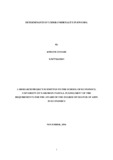| dc.description.abstract | This study investigates the main determinant of under-5 mortality in Rwanda. The study uses primary data from Rwanda Demographic Health Survey 2014-15. A discrete-time survival model with frailty (catered for unobserved heterogeneity) is applied to establish the effect of proximate variables, socioeconomic variables and environmental variables on under-5 mortality. Two different models were estimated. One examines if infant mortality (the probabilities of dying between birth and 11 months); and their child mortality (the probability of dying between 12 months and 59 months) are relatively impacted differently by covariates. The results show that unfavorable children and mother’s characteristics and household characteristics are associated with high likelihood of mortality.
The results utterly show that health care facilities are crucial for childhood mortality. Furthermore, the results show that exclusive breastfeeding, long birth spacing, being born at hospital, access to improved sanitation; access to safe source of drinking water and the use of low-polluting cooking fuel are the most important determinants of childhood survival in Rwanda. On the other hand, the result show that short birth spacing, high birth order, not being breastfed and the use of high polluting cooking fuel are statistically associated with high mortality during infancy age while unsafe source of drinking water, unimproved sanitation, high polluting fuel, not being breastfed, and short birth spacing are statistically associated with high probability of mortality during childhood age. Despite household size being favorable during infancy age, it is unfavorable at childhood age period because a big number of household members are associated by high risk of mortality. In conclusion, improvement in socioeconomic condition of household is important in reducing childhood mortality. Furthermore, a compulsory secondary education level is crucial in reducing under-five mortality in Rwanda | en_US |



